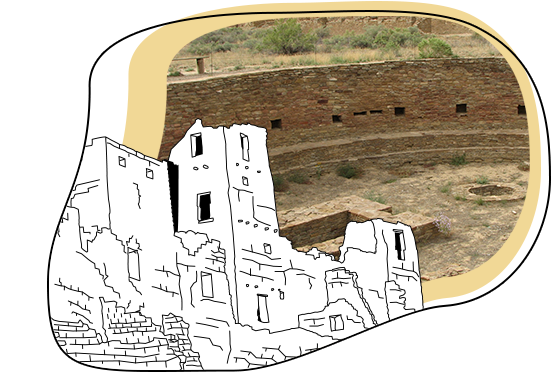The Record of the Past
So how do archaeologists study the past? The record of the past, or archaeological record, is fragmentary at best. Most of the material objects left behind are perishable. Organic materials like food or clothing decay and disappear. But some artifacts, such as pottery, stone, and bone are not as perishable, and a great deal of information about past cultures can be gleaned from them. Stone tools can tell archaeologists about types of food resources utilized – flaked stone projectile points for hunting, ground stone for grinding corn. Different types of structures can tell archaeologists about social organization. A pithouse, for instance, indicates a small family unit while a pueblo indicates a much larger and more complex social group. And an understanding of when certain artifacts appear in the archaeological record tells archaeologists when a site was occupied.
The most basic place archaeologists study is called the site. A site is any location where there is evidence of human activity. This can be a small campsite with a scatter of flaked stone indicating tools were being manufactured or modified, or it can be as large and complex as Chaco Canyon with hundreds of structures and millions of artifacts. One kind of archaeological evidence is called a feature by archaeologists, and is a non-portable group of artifacts. Features can be hearths, storage pits, architectural structures, burial mounds, or a cluster of petroglyphs at a rock art site. Evidence can also be gathered from seeds, pollen, snail shells, or animal bones that were not directly used by humans but can tell archaeologists about the diet of the people who occupied a site and what the environment was like when they lived there.
Perhaps the most important part of understanding the past is how artifacts are placed in time and space. This relationship is called context. It is based on the geological law of association, which states that objects found in the same geological level are contemporary with each other. Also, objects found in lower layers are older than those found in above them according to the geological law of superposition. These laws help the archaeologists to establish artifacts within a framework of time and space. Context is everything to an archaeologist. Without it artifacts are just objects that provide little more than general information about their function or the people who made them.
Archaeologists are like detectives. They use artifacts and the sites the artifacts come from as clues to the past. By definition an artifact is something either made or used by a human, so archaeologists try to determine what its function or purpose was in a variety of ways. For example, the form of a ceramic vessel can indicate its function. A jar could have been used for storage or cooking. Where the jar was found – near a hearth – could further point toward a cooking function. Some artifacts, like projectile points, stone knives, or ax blades demonstrate their function more clearly, but the function of others can be much less clear, at least to modern eyes. The famous “Venus” figurines manufactured by the first modern humans across Europe twenty to thirty thousand years ago are such artifacts. Animal effigies made of stone or bone or ceramic are also examples of objects whose purpose is unknown. These artifacts are often referred to as ritual, ceremonial, symbolic, or artistic by archaeologists for lack of a better word. Archaeology may never be able to explain such artifacts to any greater degree, but there are instances when new evidence sheds light on an artifact, turning a strange lump of etched rock into a Rosetta Stone.

